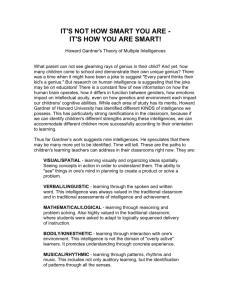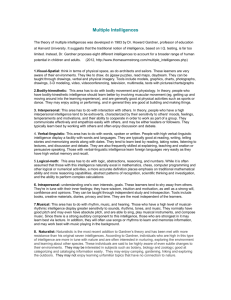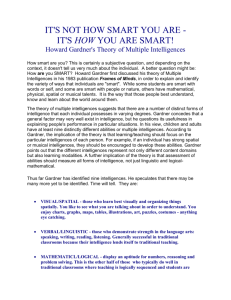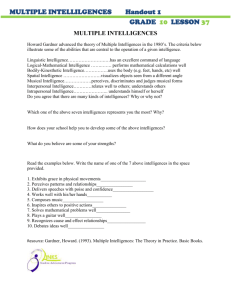MULTIPLE INTELLIGENCE
advertisement
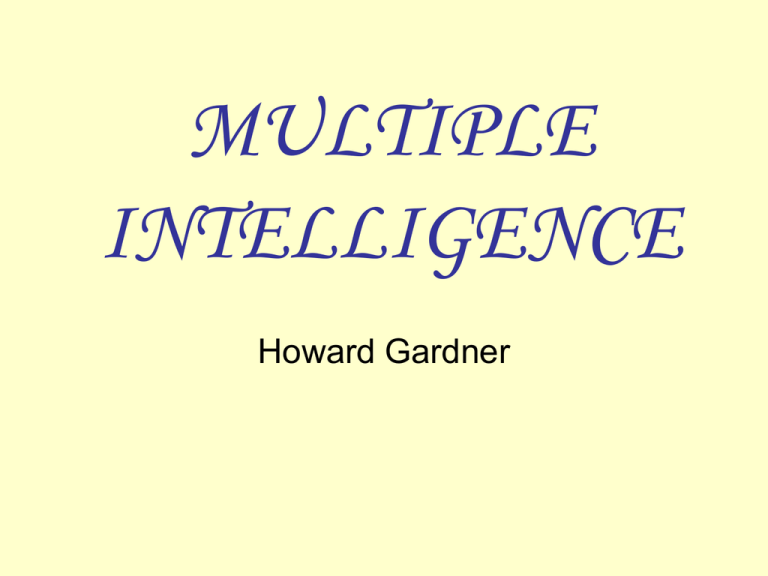
MULTIPLE INTELLIGENCE Howard Gardner • Howard Gardner's ground breaking theories were first published in Frames of Mind, 1983. • Gardner was a Harvard scholar studying work on the development of children's cognitive processes based on the work of Jean Piaget. • Through his own work on the development of cognition, he came to view those of Piaget as too narrowly focused. • In his innovative theory, he presents a new framework for considering the gifts of children. • Through studying other cultural definitions of intelligence, neurophysiology, anthropological studies and his own experimentation and observation of children, • Gardner originally devised seven categories of respective intelligence. 7 ORIGINAL INTELLIGENCES • • • • • • • Verbal/linguistic Logical/mathematical Spatial Bodily/kinesthetic Musical Interpersonal Intrapersonal • **An eighth intelligence, naturalistic/environmental, has just been recently put forth by Gardner. • While Gardner contends that all humans have some degree of all seven intelligences, there are those who are more gifted in some areas, or in combinations of areas, than in others. Here are brief overviews of each intelligence. Gardner's Intelligences Defined Verbal/Linguistic • Deals with abilities in the complex acquisition, formation and processing of language. • Thinking symbolically and reasoning abstractly fall under this category, as does the ability to create conceptual verbal patterns. • Reading, writing, the development of symbolic writing and language skills-anagrams, palindromes, metaphors, similes, puns, and analogies come under this heading. • Children who talk early, those who enjoy making sounds and rhyming patterns; children who are prolific readers and have good memories for poetry, lyrics, tongue twisters, and verse may have a propensity in this area. • These individuals love words, both spoken and written, and often think in words. They learn by verbalization, by seeing and hearing words and usually enjoy word games. • (In his work that parallels that of Gardner's, Bob Samples refers to Verbal/Linguistic and Logical/Mathematical in one category as Abstract/Symbolic intelligences. See References .) Logical/Mathematical • Deals with the ability to think logically; inductively, and to some degree deductively; categorically; to recognize patterns, both geometric and numerical; as well as the ability to see and work with abstract concepts. • Children who possess this form of developed intelligence may be constant questioners; they may easily grasp games that involve sophisticated strategies--like chess; or they may devise experimental formats to test their ideas. • Also, they may be fascinated with computers or with puzzles that involving logic and reasoning abilities. Spatial Intelligence • Deals with the ability to perceive images. • These children think in images and are usually the ones able to find missing objects due to their tremendous powers of visual recall. • They may be the first to notice things that have been changed or rearranged. • Many are earlier drawers--delighted with shapes, lines and colors. • These folks are attracted to jigsaw puzzles, mazes, find the hidden picture puzzles and they love to construct things with blocks. • They have an early sense of proportion and perspective. • They are also good at reading and constructing maps and discerning objects as they might appear in three dimensional space. • They are often referred to as daydreamers-starring off into space. • (In David Lazear's adaptation of Gardner's work, he expands this concept to include visual intelligence. Bob Samples also describes this type of ability as visual. See References .) Musical • Obviously deals with the ability to create or interpret music. • These children may need music while they study, and they are continually humming, singing, tapping out tunes rhythmically, or whistling. • They have keen ears for distinguishing sounds and subtle nuances in music and in the sounds in their environments. • These children can also be excellent mimics and can easily discern differences in speech patterns or accents. • (Again, David Lazear expands this group with the descriptor of rhythmic, and Bob Samples describes this as auditory intelligence.) Bodily/Kinesthetic • Deals with the gift of physical movement, that of both the fine and/or the large muscle systems. • These children are the movers of the universe, and frequently they squirm, rock, even fall off their chairs when required to sit still for extended periods of time. • These children are adept at creating and interpreting gestures and are often attuned at communicating in, or reading others body language. • • They may even have a need to enter the personal space of others or to touch them while communicating. • This group of students needs to learn by acting and moving, to learn by haptic experiences. Interpersonal • Deals with the ability to understand and communicate with others and to facilitate relationships and group processes. • The phrase "they can work the room " aptly describes their uncanny abilities to read people. • Often these children are highly empathetic, and they can arbitrate differences between people or groups. • They can easily pick up on the vibrations, the feelings of others. • These children enjoy cooperative learning experiences and learn best in cooperative settings. • (Bob Samples refers to this type of intelligence as synergistic personal.) Intrapersonal • Deals with the ability to be somewhat insulated from ones peers; to have a strong sense of self; to have leadership abilities in reference to making decisions that may not be popular with others. • This strong sense of self creates a certain amount of immunity from peer pressure. • These children may be what are described as "loners". • They may have gifts out the ordinary realm of human understanding--strong intuitive feelings, a sense of inner wisdom, or precognition. • These children need learning experiences where they can focus on their inner being and activities that allow them to work by themselves on material and projects of their own choosing. • (Bob Samples refers to this ability to be synergistic-natural.) • Howard Gardner's work adds new depth to understanding the multifaceted and varied dimensions of human intelligence. Under the umbrella of Gardner's definitions, American schools seemingly have few problems meeting the needs of students who have verbal/linguistic or logical/mathematical intelligences. Even in special programs that are designed for "gifted" students, many of Gardner's intelligences are not recognized or acknowledged as important or valued gifts. • As a result of this ancient, and very Western, cultural mindset, some children are elevated while others are must go wanting. And although physical giftedness appeared in the initial definitions concerning federal mandates governing gifted education, during the 70's that form of giftedness was removed from successive definitions. • This was done reportedly because schools meet the need of physically gifted children through expensive sports programs. While that is undoubtedly true for those students displaying physical traits compatible with the narrow needs of established sports, it is not true that all kinesthetically/bodily gifted students are served by schools' athletic programs. • Students having kinesthetic gifts in areas such as dance, mime, gymnastics, small muscle kinesthetic proficiencies, performance arts, table tennis and so forth, are virtually ignored by school programs. References • Armstrong, T. (1987) In their own way. Los Angeles: Jeremy P. Tarcher, Inc. • Armstrong, T. (1993) 7 kinds of smart: identifying and developing your own intelligences. New York: Plume Books (Penguin). • Armstrong, T. (1994) Multiple intelligences in the classroom. Alexandria, VA: ASCD. • Gardner, H. (1983) Frames of mind: the theory of multiple intelligences. New York: Basic Books. • Gardner, H. (1993) Multiple intelligences: the theory in practice - a reader. New York: Basic Books. • Lazear, D. (1991) Seven ways of knowing: teaching to the multiple intelligences. Palatine, IL: Skylight Publishing. • Samples, B. (1987) Wholemind/Openmind. Rollinghills Estates, CA: Jalmar Press. Special Intelligence Indicators The following descriptors are an adaptation, synthesis, or summary from many popular MI authors. (i.e. Thomas Armstrong; David Lazear; Bruce & Linda Campbell, as well as from the work of the parent MI conceptualizer, Dr. Howard Gardner. Please see their work for further details Linguistic Intelligence – (Word Smart) • Writes better than average for their age • Spins tales and tells jokes and stories • Has a good memory for names, places, dates, and trivia • Enjoys word games • Spells words accurately • Appreciates nonsense rhymes, puns, tongue twisters, etc. • Enjoys listening to the spoken word • Has a good vocabulary for his/her age • Communicates to others in a highly verbal way Logical-Mathematical Intelligence - (Number Smart) • Asks a lot of questions about how things work • Computes arithmetic questions in his/her head quickly • Enjoys the challenges of math class • Finds math games and math computer games interesting • Enjoys playing chess, checkers, or other strategy games • Enjoys working with logic puzzles and brainteasers • Likes to experiment in a way that shows higher order thinking processes • Thinks on a more abstract levels than peers • Has a good sense of cause and effect relationships for his/her age Musical Intelligence -(Music Smart) • Tells you when music is off-key or disturbing in some other way • Remembers the melody of songs • Has a good singing voice • Plays a musical instrument or sings in a choir or other musical group • Has a rhythmic way of speaking and/or moving • Unconsciously hums to him/herself • Taps rhythmically on the table or desk as he/she works • Is sensitive to the environmental noises, like rain of the roof • Can easily imitate the voices and inflections of others Spatial Intelligence – (Picture Smart) • Reports clear visual images • Reads maps, charts, and diagrams more easily than text • Daydreams more than peers • Enjoys art activities • Draws figures and pictures that are advanced for age • Likes to view movies, slides, or other visual presentations • Enjoys doing puzzles, mazes, “Where’s Waldo?” or “hidden picture” or “I spy”types activities, and challenges like hidden pictures or similar games • Builds interesting three-dimensional constructions for age (Legos) • Gets more out of pictures than words when reading • Doodles on workbooks, worksheets, or other materials Bodily-Kinesthetic Intelligence (Body Smart) • Excels in one or more sports • Moves, twitches, taps, fidgets while seated for a long time in one spot • Cleverly mimics other people’s gestures and mannerisms • Loves to take things apart and put them back together again • Has trouble keeping his/her hands off something new just seen • • Enjoys jumping, wrestling, or similar activities • Shows skill on a craft or good finemotor coordination in other ways • Has dramatic way of expressing him/herself • Reports different physical sensations while thinking or working • Enjoys working with clay or other tactile medium, and enjoys hands on art activity Interpersonal Intelligence (People Smart) • Enjoys socializing with peers • Seems to be a natural leader • Gives advice to friends who have problems • Seems to be people smart -- attuned to others • Belongs to clubs, committees, or other organizations • Enjoys informally teaching other kids • Likes to play games with other kids • Has two or more close friends • Has a good sense of empathy or concern for others • Others seek out his/her company Intrapersonal Intelligence (Self Smarts) • Displays a sense of independence or strong will • Has a realistic sense of his/her strengths and weaknesses • Does well when left alone to play or study • Marches to the beat of a different drummer in his/her style of living and learning • Has an interest or hobby that he or she doesn't talk about much • Has a good sense of self-direction • Prefers working alone to working with others • Accurately expresses how he/she is feeling • Is able to learn from his/her failures and successes • Has high self-esteem Naturalistic Intelligence (Nature Smarts) • Has a strong affinity to the outside world, to the beauty in nature, or to animals • Enjoys subjects, shows, or stories that deal with animals or natural phenomena • May show unusual interest in subjects like biology, zoology, botany, geology, meteorology or astronomy • Is keenly aware of his/her surroundings and changes in the environment • Has highly developed senses that help him/her notice similarities, differences and changes in his/her surroundings • May be able to categorize or catalogue things easily • May notice things others might may not be aware of • Likes to collect, classify, or read about things from nature — rocks, fossils, butterflies, feathers, shells, and the like • Prefers to be outside and readily appreciates and embraces activities like camping, hiking, scuba diving, bird watching, gardening, or climbing, or perhaps he/she may just like sitting quietly and noticing the subtle differences in his/her environment
